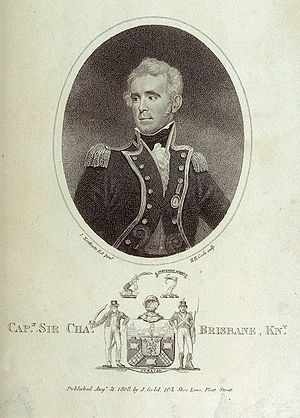- Charles Brisbane
-
Sir Charles Brisbane 
Born c.1769 Died December 1829
Saint VincentAllegiance United Kingdom of Great Britain and Ireland Service/branch Royal Navy Years of service – 1829 Rank Rear-Admiral Commands held American War of Independence - Action of 8 January 1780
- Great Siege of Gibraltar
- Battle of the Saintes
- French Revolutionary Wars
- Siege of Toulon
- Siege of Saint-Florent
- Siege of Bastia
- Napoleonic Wars
- Capture of Curaçao
- Action of 23 August 1806
Awards Knight Commander of the Bath Sir Charles Brisbane KCB (c. 1769 – December 1829) was an officer of the Royal Navy who served during the American War of Independence, and with distinction under Lords Hood and Nelson.
He took part in the capture in 1796 of three Dutch East Indiamen in Saldanha Bay, the capture of the Spanish frigate Havana, Cuba in 1806 and then in 1807 the island of Curaçao was captured under his command. He was made governor of St. Vincent in 1808, and served as such until his death in 1829.
Contents
Family and early life
Charles Brisbane was born circa 1769, the fourth but eldest surviving son of Admiral John Brisbane. He was entered on board HMS Alcide, commanded by his father, in 1779. He was present at the action of 8 January 1780, and the relief of the Great Siege of Gibraltar in January 1780, and later served in the West Indies. At the end of 1781 he was placed on board HMS Hercules with Captain Henry Savage, and was present at the Battle of the Saintes off Dominica, on 12 April 1782, where he was badly wounded by a splinter.[1]
He continued serving during the peace, and after the Spanish armament in 1790 was promoted to the rank of lieutenant on 22 November. In 1793 he was aboard the frigate HMS Meleager, in which he went out to the Mediterranean, and was employed on shore at Toulon during the occupation of the city, and afterwards in Corsica, both at the siege of Saint-Florent and at the siege of Bastia. Brisbane was under the immediate orders of Captain Horatio Nelson, and like him sustained the loss of an eye from a severe wound in the head inflicted by the small fragments of an iron shot. He then served for a short time in HMS Britannia, bearing the flag of Admiral Lord Hood, by whom he was promoted to the command of the sloop Gulf of Genoa, under the immediate orders of Nelson.[1]
Command
In the autumn of 1795 he was sent from Gibraltar to convoy two troopships to Barbados. On his way there he fell in with a Dutch squadron, which he kept company with, sending the transports on by themselves; finding that the Dutch were bound for the Cape of Good Hope, he carried the intelligence to Sir George Elphinstone, the commander-in-chief on that station, acting contrary to the orders under which he had sailed. After the capture of the Dutch ships in Saldanha Bay on 18 August 1796, he was promoted by Sir George to the command of one of them; he had previously, 22 July, been promoted by Sir John Jervis, the commander-in-chief in the Mediterranean, under whose orders he had sailed, and he also received the thanks of the admiralty.[1]
He continued on the Cape station in command of the frigate Saint Helena when a mutiny broke out on board. This he quelled decisively, and he was shortly afterwards recalled to the Cape to take command of HMS Tremendous, Rear-Admiral Thomas Pringle's flagship, on board which also there had been mutineers. In the course of 1798 he returned to England with Pringle in command of the frigate Brest, under Admiral William Cornwallis.[1]
Napoleonic Wars
During the short Peace of Amiens he commanded the frigate hurricane. In 1805 Brisbane was appointed to the frigate HMS Arethusa, which he took to the West Indies. Early in 1806 he ran the ship ashore amongst the Colorados rocks, near the north-west end of Cuba, and she was got off only by throwing all her guns overboard. In this defenceless condition she fell in with a Spanish ship of line off Havana; but this enemy ran in under the guns of Morro Castle. Having refitted at Jamaica, the Arethusa was in August again off Havana, and on the 23rd, in company with the 44-gun HMS Anson, captured the Spanish frigate
- ^ a b c d e f g
 "Brisbane, Charles". Dictionary of National Biography. London: Smith, Elder & Co. 1885–1900.
"Brisbane, Charles". Dictionary of National Biography. London: Smith, Elder & Co. 1885–1900. - Attribution
On 1 January 1807 Brisbane, still in Arethusa, with three other frigates, having been sent off Curaçao, reduced the forts and captured the island from the Dutch. For his success on this occasion Brisbane was knighted, and he, as well as the other three captains, received a gold medal. He continued in command of the Arethusa till near the end of 1808, when he was transferred to the 74-gun HMS Blake, but was almost immediately afterwards appointed governor of the island of Saint Vincent. He held the post, without any further service at sea, until his death on the island in December 1829. On 2 January 1815 he had been nominated a KCB, and attained his flag rank on 12 August 1819.[1]
Family
He married Sarah, daughter of Sir James Patey, of Reading, and left several children.[1]
References
![]() This article incorporates text from a publication now in the public domain: "Brisbane, Charles". Dictionary of National Biography. London: Smith, Elder & Co. 1885–1900.
This article incorporates text from a publication now in the public domain: "Brisbane, Charles". Dictionary of National Biography. London: Smith, Elder & Co. 1885–1900.
| Preceded by George Beckwith |
Governor of Saint Vincent 1808–1829 |
Succeeded by William John Struth (acting) |
